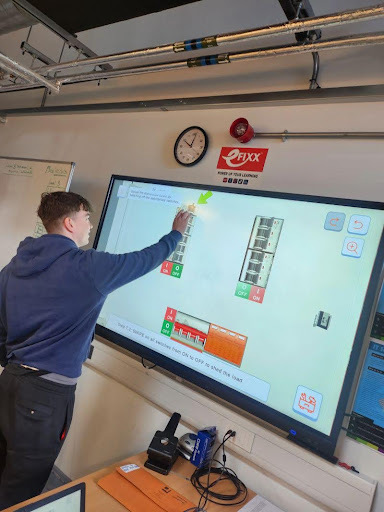Getting hands-on experience during your electrical study is an important part of future electricians. But the old-school method comes with dangers and risks during the learning, and inexperienced students may encounter a problem that could be fatal.
It has become a major challenge for teachers and instructors to teach their students safe isolation techniques without getting themselves in danger.
At Tameside College, instructor Matthew Davis opts for a way to bridge the gap between theory and hands-on experience. By introducing the Tradefox Safe Isolation Simulator, he found a solution that made training safer, more engaging, and highly effective.
This simulation training enables students to learn different techniques using touch-screen technology to handle complex challenges that they will face in real life.
By integrating this tool into the curriculum, Matthew managed to enhance student engagement and improve knowledge retention.
A Classroom Without Risk
While necessary real-world practice carries risks that can make students hesitant to fully engage, the Tradefox Safe Isolation Simulator removed this barrier by allowing learners to complete the entire isolation procedure in a virtual setting.
Matthew noted that the application worked seamlessly on touch screens, creating an interactive experience that kept students involved. This method enabled them to gain confidence in their skills before applying them in real-life situations. Without the pressure of working with live systems, students could focus on mastering each step of the isolation process.
Enhancing The Learning Experience
With the simulator, Matthew was able to expand the way electrical concepts were taught in his classroom. He developed display boards covering the wiring of lights, sockets, and other components, reinforcing the theory behind electrical installations.
Posters illustrating safe isolation steps, common tools, and testing procedures became valuable reference materials, helping students absorb information more effectively.
Interactive resources like the simulator transformed the learning process into something more dynamic. Instead of passively absorbing information, students actively participated in their education.
This shift made lessons more engaging, leading to noticeable improvements in their understanding of key concepts.
New Learning Experiences For The Next Generation Of Electricians
One of the major problems that the electrical sector faces is getting new talent into the industry. Most students prefer taking up careers that are more modern and technology-involved for practical work, and some traditional methods of training are not that engaging.
Matthew spoke about interactive training he developed explaining how in his opinion, it is the easiest way to capture students’ interest in the electrical trade.
The training tool aided students’ self-assurance by creating an engaging and safe environment.
Students did not have to be overly concerned about making irreversible errors as they were learning.
This allowed them to do more practice, more mistakes, and more learning. These steps made the lessons more engaging and more importantly, made the retention of the information easier for the students.
Final Words
The introduction of the Safe Isolation Simulator at Tameside College has proven that modern technology can transform the way electricians are trained. By eliminating risks, enhancing engagement, and improving knowledge retention, this tool is helping to shape a smarter and safer workforce.
For those in the industry looking to explore better ways to train future professionals, the results at Tameside College offer a clear example of what is possible. To learn more about the Safe Isolation Simulator and how it is changing electrical education, visit Tradefox.


